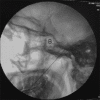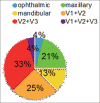Radiofrequency Treatment of Idiopathic Trigeminal Neuralgia (Conventional vs. Pulsed): A Prospective Randomized Control Study
- PMID: 34667342
- PMCID: PMC8462427
- DOI: 10.4103/aer.aer_56_21
Radiofrequency Treatment of Idiopathic Trigeminal Neuralgia (Conventional vs. Pulsed): A Prospective Randomized Control Study
Abstract
Background: Idiopathic trigeminal neuralgia (TGN) is a chronic pain disorder causing unilateral, severe brief stabbing recurrent pain in the distribution of one or more branches of the trigeminal nerve. Conventional radiofrequency (CRF) and pulsed radiofrequency (PRF) are two types of minimally invasive treatment. CRF selectively ablates the part of ganglion to provide the relief, but it has been found to be associated with some side effects such as dysesthesia or sensory loss in 6%-28% and loss of corneal reflex in 3%-8% of patients. PRF is a comparatively newer modality which is a nondestructive and neuromodulatory method of delivering radiofrequency energy to the gasserian ganglion to produce a therapeutic effect.
Aims: We aimed to compare the efficacy of CRF with long-duration, fixed voltage PRF in the treatment of idiopathic TGN.
Setting: This study was conducted in a tertiary care center research institute.
Study design: This was a prospective randomized trial.
Materials and methods: Twenty-seven adult patients of TGN were included in the study and randomly allocated into two groups (CRF and PRF). All procedures were performed operation suite with C-arm fluoroscopic guidance. Both, pre- and postprocedure, the patients were assessed for pain on the Visual Analog Scale (VAS) and Barrow Neurological Institute (BNI) Pain Intensity Scale at 1 week and thereafter at 1, 2, 3, and 6 months. Patients with a BNI score ≥4 after 1 month were considered a failure and offered other modes of treatment. A reduction in VAS score ≥50% and a BNI score <4 were considered as effective.
Statistical analysis: Discreet variables were recorded as proportions, ordinal variables and continuous variables with non-Gaussian distribution as medians with interquartile range, and continuous variables with Gaussian distribution as mean ± standard deviation. Association between ordinal variables was tested by Fisher's exact test/Chi-square test whenever appropriate. Equality of means/median was tested by using paired/unpaired t-test or nonparametric tests depending upon the distribution of data. P ≤ 0.5 was considered statistically significant. Data analysis was performed using STATA version 13.04 windows.
Results: Efficacy in terms of decrease in VAS ≥50% at 1 month was 33.33% and 83.33% in the PRF and CRF groups, respectively, which was statistically significant(P = 0.036). Effective reduction in BNI scores at the 7th day, 1 month, and 2 months postprocedure was evaluated and found in 41.67% and 83.33% of patients in the PRF and CRF groups, respectively, which was statistically insignificant (P = 0.089). There was a statistically significant reduction in BNI scores in PRF and CRF group patients at 3 and 6 months (at 3 months, 33.33% and 83.33%, P = 0.036 and at 6 months, 25% and 83.33%, P = 0.012). In the CRF group, mild hypoesthesia was evident in three patients which improved by the end of 1 month while no side effects were seen in the PRF group.
Conclusion: CRF is a more effective procedure to decrease pain in comparison to long-duration, fixed voltage PRF for the treatment of idiopathic TGN. Although the side effects are more with CRF, they are mild and self-limiting.
Keywords: Conventional radiofrequency; facial pain; pulsed radiofrequency; trigeminal neuralgia.
Copyright: © 2021 Anesthesia: Essays and Researches.
Conflict of interest statement
There are no conflicts of interest.
Figures
Similar articles
-
The Efficacy and Safety of the Application of Pulsed Radiofrequency, Combined With Low-Temperature Continuous Radiofrequency, to the Gasserian Ganglion for the Treatment of Primary Trigeminal Neuralgia: Study Protocol for a Prospective, Open-Label, Parall.Pain Physician. 2021 Jan;24(1):89-97. Pain Physician. 2021. PMID: 33400432
-
Radiofrequency Thermoablation of the Gasserian Ganglion Versus the Peripheral Branches of the Trigeminal Nerve for Treatment of Trigeminal Neuralgia: A Randomized, Control Trial.Pain Physician. 2019 Mar;22(2):147-154. Pain Physician. 2019. PMID: 30921978 Clinical Trial.
-
High-Voltage, Long-Duration Pulsed Radiofrequency on Gasserian Ganglion Improves Acute/Subacute Zoster-Related Trigeminal Neuralgia: A Randomized, Double-Blinded, Controlled Trial.Pain Physician. 2019 Jul;22(4):361-368. Pain Physician. 2019. PMID: 31337167 Clinical Trial.
-
Treatment of trigeminal neuralgia by radiofrequency of the Gasserian ganglion.Rev Neurosci. 2016 Oct 1;27(7):739-743. doi: 10.1515/revneuro-2015-0065. Rev Neurosci. 2016. PMID: 27383870 Review.
-
Radiofrequency Therapies for Trigeminal Neuralgia: A Systematic Review and Updated Meta-analysis.Pain Physician. 2022 Dec;25(9):E1327-E1337. Pain Physician. 2022. PMID: 36608005
Cited by
-
Effectiveness and safety of high-voltage pulsed radiofrequency to treat patients with primary trigeminal neuralgia: a multicenter, randomized, double-blind, controlled study.J Headache Pain. 2023 Jul 18;24(1):91. doi: 10.1186/s10194-023-01629-7. J Headache Pain. 2023. PMID: 37464283 Free PMC article.
-
The long-term outcome of CT-guided radiofrequency ablation of the peripheral branches of the trigeminal nerve in trigeminal neuralgia.Neurosurg Rev. 2024 Jan 6;47(1):33. doi: 10.1007/s10143-023-02269-w. Neurosurg Rev. 2024. PMID: 38182916
-
Ultrasound-Guided Radiofrequency Ablation and Pulsed Radiofrequency Treatment for Chronic Lameness Due to Distal Forelimb Disease in Horses: A Pilot Study.Animals (Basel). 2025 Aug 10;15(16):2341. doi: 10.3390/ani15162341. Animals (Basel). 2025. PMID: 40867669 Free PMC article.
-
Robot-assisted percutaneous balloon compression for trigeminal neuralgia- preliminary experiences.BMC Neurol. 2023 Apr 22;23(1):163. doi: 10.1186/s12883-023-03199-2. BMC Neurol. 2023. PMID: 37087440 Free PMC article.
References
-
- Loeser J. Tic douloureux. Pain Res Manag. 2001;6:156–65. - PubMed
-
- Classification of chronic pain. Descriptions of chronic pain syndromes and definitions of pain terms.Prepared by the International Association for the Study of Pain, Subcommittee on Taxonomy. Pain Suppl. 1986;3:S1–226. - PubMed
-
- Headache Classification Committee of the International Headache Society (IHS) The International Classification of Headache Disorders, 3rd edition (beta version) Cephalalgia. 2013;33:629–808. - PubMed
-
- Burchiel KJ. A new classification for facial pain. Neurosurgery. 2003;53:1164–6. - PubMed
-
- Subashree R. Medical management of trigeminal neuralgia. IOSR J Dent Med Sci. 2013;12:36–9.
LinkOut - more resources
Full Text Sources
Medical
Miscellaneous




